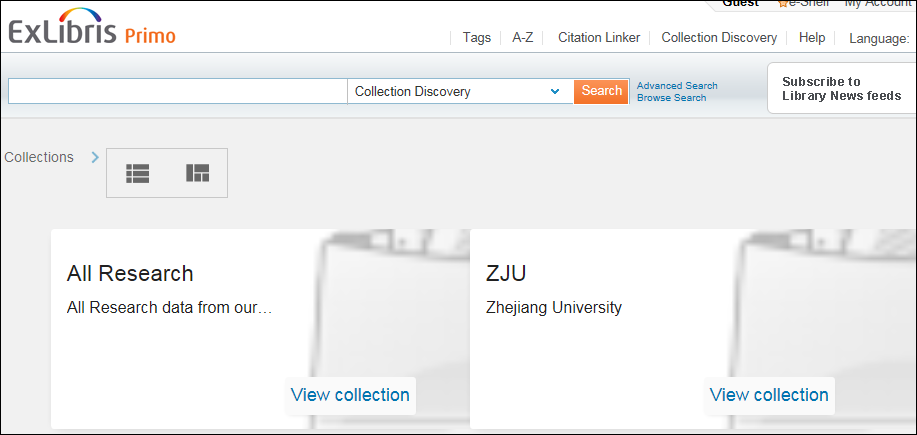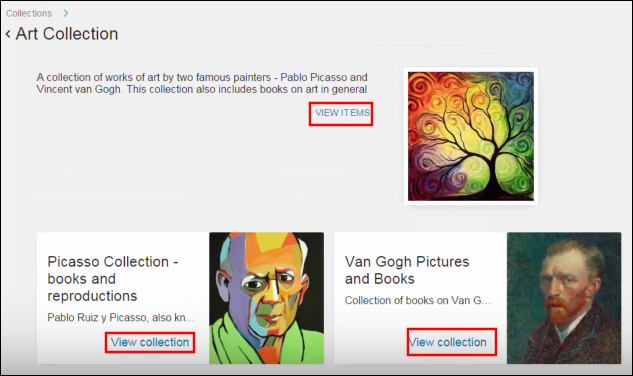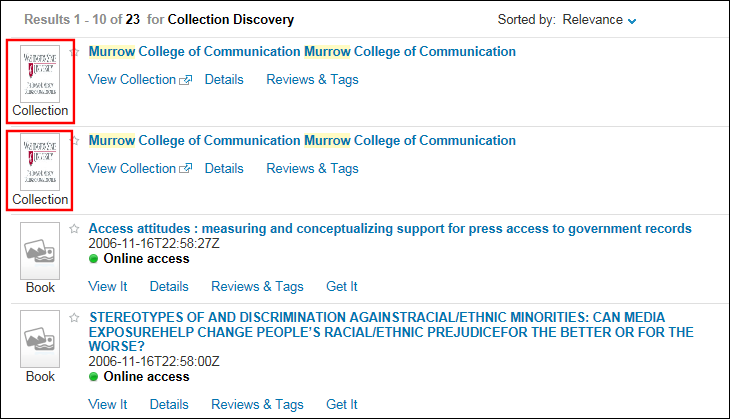Primo February 2016 Highlights
Introduction
This guide summarizes the various enhancements and changes that are new for the February 2016 release of Primo. The most significant changes were made to the following areas: User Experience, Administrator Tools, Developer Tools, and Primo Analytics.
For information regarding defect fixes, see Release Notes.
Primo February Release Highlights – Webinar
To download the Webinar, click the following link: Primo February Release
New User Experience Functionality
The updates to the Front End include the following main enhancements:
Collection Discovery
This enhancement provides users an intuitive and visual way of searching for collections from Alma and Rosetta as part of the Primo discovery interface.
Collection Discovery Page
The new Collection Discovery page contains the standard Primo header, search box, and a new Collections Lobby panel that displays all top-level collections defined in Alma and Rosetta. In addition, a new search scope has been added to allow users to search collections.

Collection Discovery Page
Collections Lobby
The Collections Lobby displays all top-level collections using either a grid (default) or list format. From the top-level, users can view the contents of the collection, which may consist of subcollections and items.

Collections Lobby Panel
You can access the Collections Lobby in the following ways:


Collection Discovery Button
- Click the Collection Discovery button at the top of the page.
- Use the following deep link to access the page: http://<primo domain>/primo_library/libweb/action/dlcollectionLobby
Parameters:
- vid - the view ID
- inst - the institution of the view.
- colayout - the format of the collections in the Collections Lobby. Specify either grid or list.
- collectionid (optional) - the ID of the collection to which you want to give focus on the page.
Navigating Collections
Depending on the hierarchy of your collection, you can use the following links to navigate your collections:
- The View Collection link allows you to view the contents of a top-level collection or a subcollection. Clicking this link displays the next level in a collection's hierarchy. Each level may contain a combination of View Items and View Collection links.
- The View Items link allows you to view the items included in a collection or subcollection. Clicking this link displays the standard Primo results page, where users can display the items or get more information.

Navigation Links
You can click the breadcrumbs to navigate back to any level of the collection's hierarchy.

Collection Lobby Breadcrumbs
Searching Collections
The Collection Discovery search scope (if enabled for the view) allows users to search for both collections and items using the Primo Search Box.

Collection Discovery Search Scope
Out of the box, users will be able to search for collections in existing scopes.
In the search results, collections are indicated by a new Collection resource type:

Collection Resource Type
From the search results, you can perform the following actions:
- For collections, you can click View Collections to open the collection in the Collections Lobby.
- For items in a collection, you can click View It to display the item.
- For both items and collections, you can click the Details tab to display more information about the collection (such as the collection path).
Delivery of Collections
Items that are part of a collection are standard Primo PNX records that can be any one of the existing delivery categories. To support the collection hierarchy, the following delivery categories have been added:
- Alma-C - The delivery category for Alma collections.
- Collection - The delivery category for Rosetta collections and potentially other systems.
Out of the box, collections will have a single delivery option (GetIt1), which is used to invoke the collection path. For example:

Collection Path
The availability status for collections is not provided and will not display in the results list. For example:

No Availability Shown for Collections
Back Office Configuration
Many of the Back Office configurations are provided out of the box. For details on how to enable this functionality, refer to Collection Discovery.
British/American Synonyms
This enhancement adds words in which the British and American spellings are different (such as defence/defense) to the synonyms file. This allows users to use their regional spelling in queries and find material that contains either spelling.
New Administrator Tools Functionality
The updates to the Back Office include the following enhancement:
Primo-Alma Course Reserves
Previously, Alma customers were required to configure the normalization and display of course reserves locally by using local display, search, and facet fields. This enhancement provides an out-of-the-box configuration for Alma course reserves.
Description
Alma course reserve information is defined in the MARC CNO field, which contains the following subfields:
- $$a – institution
- $$b – start date
- $$c – end date
- $$e – processing department code
- $$f – processing department name
- $$g – instructor
- $$j – course name
- $$k – course ID and section
- $$l – course department
For example:
<datafield tag="CNO" ind1="" ind2="">
<subfield code="a">01ALLIANCE_UW</subfield>
<subfield code="b">201412150317+-317</subfield>
<subfield code="c">201503310217+-217</subfield>
<subfield code="e">Reserve Processing Unit</subfield>
<subfield code="f">ReserveProc</subfield>
<subfield code="g">Bube, Kenneth P.</subfield>
<subfield code="j">Mathematics 465</subfield>
<subfield code="k">MATH 465.(WI 15)</subfield>
<subfield code="l">Mathematics</subfield>
<subfield code="o">WI1516771</subfield>
<subfield code="o">mrl</subfield>>
<subfield code="r">2015</subfield>
</datafield>
Primo's normalization rules will now map the data from the subfields shown in bold above so that they will display in search results.
Back Office Configuration
No additional configuration is necessary. The following table lists the fields that were added to the PNX to map course reserves data from Alma:
| Section | Field | Code |
|---|---|---|
| Display | Course info | crsinfo |
| Facets | Course name Course instructor Course ID Course department |
crsname crsinstrc crsid crsdept |
| Search | Course name Course instructor Course ID Course department |
crsname crsinstrc crsid crsdept |
The following codes were added to the Facet Labels code table under the Front End subsystem to support course reserve information, which is displayed in the Details tab of search results:
| Code | Description |
|---|---|
| facets.facet.facet_crsinfo | Course info |
| facets.facet.facet_crsname | Course name |
| facets.facet.facet_crsinstrc | Course instructor |
| facets.facet.facet_crsid | Course ID |
| facets.facet.facet_crsdept | Course department |
The following changes have been made to the Alma MARC normalization rules template.
Display Section:
Added a rule that concatenates the four new fields using the following format:
<course ID> : <course name> ; <course department> ; <course instructor>
The following example is taken from the example provided in the Description section:
MATH 465.(WI 15) : Mathematics 465 ; Mathematics ; Bube, Kenneth P.
Facets Section:
The following tables lists the rules that were added to the Facets section of the PNX:
| Field | Rule |
|---|---|
| facet/Course name | Retrieve data from MARC CNO field subfield j Transformation: Copy as is |
| facet/Course instructor | Retrieve data from MARC CNO field subfield g Transformation: Copy as is |
| facet/Course ID | Retrieve data from MARC CNO field subfield k Transformation: Copy as is |
| facet/Course department | Retrieve data from MARC CNO field subfield l Transformation: Copy as is |
Search Section:
The following tables lists the rules that were added to the Search section of the PNX:
| Field | Rule |
|---|---|
| search/Course name |
|
| search/Course instructor | Retrieve data from MARC CNO field subfield g Transformation: Copy as is |
| search/Course ID |
|
| search/Course department | Retrieve data from MARC CNO field subfield l Transformation: Copy as is |
| search/searchscope | Retrieve data from MARC CNO field subfield a Transformations: Use Mapping table: Alma Institution Codes Add to end of string: _CR
|
New Developer Tools Functionality
The updates to the development tools include the following enhancement:
jQuery.PRIMO Library Added to Primo Release Package
This enhancement adds the jQuery.PRIMO library to the PRIMO release package, which allows you to use it without manually loading and updating files from the Developer Network. This library is provided by Mehmet Celik of KU Leuven. For more information on using this library, refer to the following page:
New Primo Analytics Functionality
The updates to Primo Analytics include the following enhancement:
Device Usage Information for Primo Analytics
The Device Usage Subject Area has been added to Primo Analytics to allow you to create dashboards and reports based on the type of device.

Device Usage Example
Description
The Primo Device Usage subject area includes the following fact tables: Device Usage, Dates, and Institutions.

Primo Device Usage Subject Area
The following table describes each of the tables in the Primo Device Usage subject area:
| Field | Description |
|---|---|
| Device Usage | The fact table that stores measures and attributes of device usage. |
| Dates | The date dimension table that enables filtering for different periods. |
| Institutions | The dimension table for the institution. |
Device Usage
The Sessions table is the fact table that stores information about sessions.

Device Usage Table
The Sessions fact table has four measurement fields and one attribute fields:
| Field | Description |
|---|---|
|
Sessions
|
The number of times in which a type of device was used.
|
|
Actions
|
The number of actions for a device type.
|
|
Signed-in
|
A measurement field that tracks the number of times a user signed in when using a type of device.
|
|
On Campus
|
A measurement field that tracks the number of times a user was on campus when using a type of device.
|
|
Browser Type
|
An attribute field that stores the type of browser.
|
|
Device
|
An attribute field that stores the type of device.
|
|
Operating System
|
An attribute field that stores the type of operating system. It allows you to merge different versions of the same operating system into a single value.
|
|
Primo View
|
An attribute field that stores the View in which the device was used.
|
Dates
The Dates is a dimension table for different date ranges and format. The dates dimension can be used to limit reports to specific date ranges (such as year, month, week, and day).
Institutions
The Institutions table is a dimension table with the following attributes: Primo Institution Code and Institution Name.

Institutions Dimensions Table

